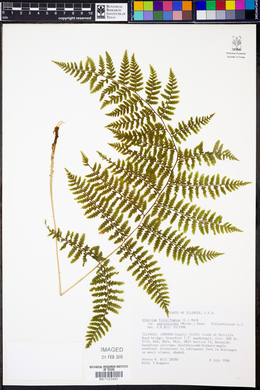Athyrium filix-femina var. asplenioides
|
|
|
|
Family: Athyriaceae
Lady Fern
|
Petiole 13--55 cm; scales light brown or brown, lanceolate, 6--9 × 2 mm, ± crisped. Blade ovate-lanceolate to lanceolate, 2-pinnate-pinnatifid, (18--)25--60 × (5--)10--30 cm, slightly narrowed proximally, broadest just above base to just below middle, apex acuminate or ± caudate. Pinnae usually stalked, oblong-lanceolate to lanceolate, base truncate, apex acuminate. Pinnules oblong-lanceolate to narrowly deltate, base unequally cuneate, apex ± acute. Rachis , costae, and costules glabrous or with scales or pale glands. Sori elongate, straight or hooked at distal end or horseshoe-shaped; sporangial stalks with glandular hairs; indusia ciliate, hairs glandular or nonglandular and ± as long as indusial width. Spores brown or dark brown. 2 n = 80. Moist woods, thickets, swamps; 10--2000 m; Ala., Ark., Conn., Del., Fla., Ga., Ill., Ind., Kans., Ky., La., Md., Mass., Miss., Mo., N.J., N.Y., N.C., Okla., Pa., R.I., S.C., Tenn., Tex., Va., W.Va. Petiole nearly or fully as long as the blade, the basal scales pale; blade widest below the middle, the second or third pair of pinnae the largest; cilia of the indusium gland- tipped; spores dark brown or blackish. Fla. to e. Tex., n. to R.I., Pa., s. Ind., Mo., Okla., and e. Kans. (A. asplenioides) Gleason, Henry A. & Cronquist, Arthur J. 1991. Manual of vascular plants of northeastern United States and adjacent Canada. lxxv + 910 pp. ©The New York Botanical Garden. All rights reserved. Used by permission. From Flora of Indiana (1940) by Charles C. Deam This [variety] and the next [A. filix-femina var. angustum] are the results of dividing an aggregate that formerly had been designated as A. Filix-femina. For a detailed study of this group see Butters' "Synoptical treatment of the Lady Ferns of Eastern North America" (Rhodora 19: 188-197. 1917). Butters has gone into great detail in his study of the species and discusses "sun" and "shade" forms. Some recent authors are disposed to regard some of the forms as merely ecological variations. See Wiegand's comment on varieties of the next species in "The Flora of the Cayuga Lake Basin," page 32. 1926. Pinkerton in "Ferns of Missouri" (Ann. Missouri Bot. Gard. 20: 55. 1933) says: "This species and A. angustum are very difficult to distinguish. It is often necessary to have the whole plant, fruiting and not too mature, to be absolutely certain. I have taken the character of the spore as my ultimate criterion." I can not satisfactorily 'separate the species and their varieties and would not publish on them were it not that C. A. Weatherby has named nearly every one of my specimens. I hereby wish to express my appreciation of the difficult task of naming so many of my specimens of this complex. Infrequent in the southern counties but frequent in its habitat. It prefers a hard, white, moist, clay soil and is usually found in low, flat woods associated with beech and sweet gum or sweet gum and pin oak. It is also found in residual soil at the base of sandstone cliffs and in sandstone soil on wooded slopes. ...... Indiana Coefficient of Conservatism: C = 6 Wetland Indicator Status: FAC |


















































































